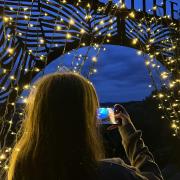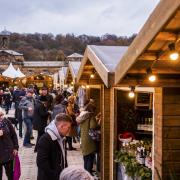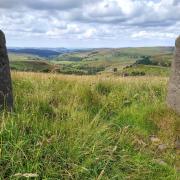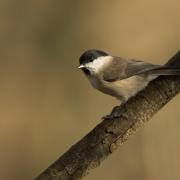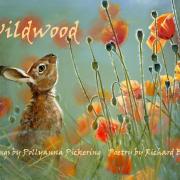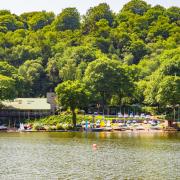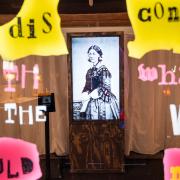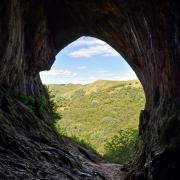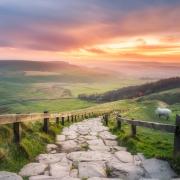Derbyshire is blessed with magical forests and woodlands, tucked beneath Dark Peak moorland to the west of the National Park. Stride out and enjoy the last of the autumn colour.

Snake Woodlands walk
High up on Snake Pass, you’ll find Snake Woodlands. It’s a magical forest, not without its issues, but well worth an exploration.
Two storms passed through last year, bringing down many of its conifers, while fungal disease is attacking the forest’s Corsican and lodgepole pines (dothistroma needle blight) and Japanese larch disease is devastating these beautiful deciduous conifers.
Fly-tipping is an ongoing headache for Forestry England with camping and barbecue remains marring this beautiful woodland.
Don’t let this put you off: the further you walk from the car park (on the right of the pass), the more pristine the forest becomes; it’s an otherworldly place of tumbling water, moss and forest grasses and soaring conifers.
Crossing the busy Snake Pass road carefully, drop down to a bridge, following the brook of Lady Clough a short way before climbing onto the hillside.
It helps at this stage to have the OS app on your phone to guide you along the permitted footpath, but there are other features to look out for: the little wooden bridges that cross gullies, wooden stumps or stones marking the edge of the path and gravel showing through the pine needles.
The path rises and falls through the woodland between Snake Pass and the river. Eventually, it drops to the water again, where you’ll come to a wooden footbridge.
Before crossing it, continue up the river a short way to enjoy the rapids that tumble off Lady Clough. It’s a great part of the woodland to settle down with a hot drink or picnic lunch.
You could try to return to your starting point along the riverbank where the path is wide and flat much of the way, but fallen trees block the waterside desire line in places and the occasional collapsed bank and marshy section may make the going challenging.
Crossing the bridge, the path winds up the hillside, views opening out to the valley below. This side of the plantation is covered with young fir trees, crowding the hillside to the point where they have seeded along the narrow pathway.
Here you have no choice but to fight your way through Christmas trees, making it a rather prickly experience.
I later met a Forestry England employee who told me there aren’t the resources to maintain the path: go now while you can just about manage to push your way through the young trees.
This part of the woodland is lovely. Few venture this way, and the footprints in the mud will tell you that apart from the odd human and dog, it’s mainly deer passing through.
With relief you’ll meet the circular turning point for Forestry England vehicles. From here the path is wide and pleasant to walk on.
Look for the lovely sphagnum moss. Small and delicate with beautiful clusters of star-like leaves, this moss helps prevent vegetation from decaying, playing an important role in creating peat.
As you saunter along the forest track, drink in the conifers soaring to the Dark Peak sky. Breathe in slowly and take in the healing beauty of the forest.
Soon you will come to a fork. Take a sharp left to drop down to a bridge. Cross it and turn left to meet the footbridge you encountered at the start of your walk.
From here it’s just a matter of retracing your steps uphill back to the car park, the end of your 2.3-mile ramble.

Errwood Hall and Cemetery
This is a short but sweet walk (just 1.5 miles) through parkland that once belonged to the Grimshawe family, who made their money in the Industrial Revolution.
The walk through the extended grounds of their house feels very different from the uniform planting of conifers elsewhere along Errwood Reservoir, where pines have been planted close together by Forestry England ensuring they grow tall and straight for good commercial timber.
In contrast, the old parkland and gardens, now returning to nature, were planted with a wide variety of broadleaves, firs and pines, inspired by the Grimshawes’ travels.
It’s an atmospheric place, one in which you can almost sense of ghosts of this once wealthy family as you explore the grounds, ruins and cemetery.
From Errwood Hall car park take the broad path to the left of the car park. At a meeting of tracks keep right to follow the wide path along then up the valley. It’s a magical dell of tumbling brooks and mature trees.
Sadly, many of the larches, rhododendrons and sweet chestnuts planted by the Grimshawe family are being felled now because of Phytophthora ramorum, a water mould that is particularly devastating in larch.
But never fear, there are plenty of magnificent trees left to enjoy. Take a sharp right to follow the wide track up to Errwood Hall.
Steps ascend to the ruins, unfortunately closed off due to vandalism. Through the mesh, you can still appreciate the grandeur of this once stately home with its remnant arched windows and entrances, sweeping stone steps and curved stone carved with the family’s coat of arms.
Turning your back on the frontage with its arched and mullioned windows, climb up steps to get a high-level view over the ruins, then turn right to climb the path that runs parallel to the wider track in the dell below.
Running along the boundary of the gardens, you’ll see mossy steps, then pillars, indicating the hall’s entrance. It’s not hard to imagine the ladies of the house swishing through the grounds in their long skirts or capped gardeners hard at work. I wonder how they would feel today if they could see the ruins of their magnificent country house and overgrown gardens?
Going through the pillars, continue up the track to the ruins of Castedge Cottage, appearing as a pile of stones. You can just about make out the foundation walls at one end.
Here you’ll see multiple signposts at a crossroads of paths. Follow in the direction of Foxlow Edge, looking out for a grassy path heading up to the knoll on your right. As the path levels out, you’ll see some yews on your right (an indication that the graveyard is not far off) and sure enough just after you’ll see the sign pointing the way to the Grimshawe cemetery.
At the top of the knoll go through the wooden gate to the family burial plot with the grave of Samuel Grimshawe, buried in 1883, his wife and son (who died in infancy), alongside favoured servants and the last of the Grimshawes, Mary, who died in 1930.
Take in this local slice of history, rest on the bench provided and admire the partially open views to the high moorlands.
Having caught your breath from the climb, retrace your steps down off the knoll, turning right to continue downhill to a junction of paths.
Turn right again to cross the footbridge below steps and keep right to follow the brook through a thickly wooded ravine.
You’ll arrive back at the east side of Errwood Hall. Keep following the path, eventually meeting the track you’d climbed up earlier.
Retrace your steps here, this time taking the shortcut straight down the grassy hillside to the car park.

Fernilee Reservoir
This 3.5-mile ramble is one of pure delight. It takes you through mixed woodland beside the water, returning you through Forestry England plantation with expansive higher-level views over the reservoir, forests and moorlands.
Starting at The Street car park, head to the junction of The Street and Goyt’s Lane. Follow the wooden fingerpost along the grassy path that lies between the two roads, dropping diagonally towards the dam, keeping to the lower path that eventually reaches the waterside path.
The woodland takes you through a variety of broadleaves, with a couple of benches along the way. Enjoy a waterside picnic before climbing up to a broader path. Turn right and follow the path, now higher up from the water.
If you’re lucky, you’ll see cormorants roosting on a couple of trees. There’s about fifteen of them that have taken up residence on the banks of the reservoir, a passerby told me. Occasionally they’ll spread out their (not very waterproof) wings to dry.
At the head of Fernilee Reservoir, turn left to climb the farm track. A short stiff climb will bring you to the farm entrance. Turn left here to follow the forest track back towards The Street car park. There are some lovely spruces along the way and mature beeches with impressive girths.
The path eventually reaches The Street, but rather than dropping down the road, turn left just before it to take a tree-edged path downhill, then turn right at its end to return to the path that leads back to the junction of The Street and Goyt’s Lane (keeping to the high ground).
While the waterside path is popular with dog walkers, you’ll not meet many people on the forest track. Relax, stop frequently to enjoy the views and do a bit of ‘forest bathing’ - just soaking in the woodland goodness.
READ MORE: Peak District walk: Baslow, Bank Wood and Bramley Wood




